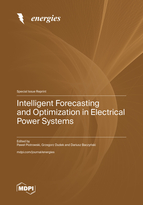Intelligent Forecasting and Optimization in Electrical Power Systems
A special issue of Energies (ISSN 1996-1073). This special issue belongs to the section "F1: Electrical Power System".
Deadline for manuscript submissions: closed (15 December 2022) | Viewed by 39800
Special Issue Editors
Interests: artificial intelligence; machine learning; forecasting; optimization; power engineering
Special Issues, Collections and Topics in MDPI journals
Interests: machine learning; data mining; artificial intelligence; pattern recognition; evolutionary computation; their application to classification, regression, forecasting and optimization problems
Special Issues, Collections and Topics in MDPI journals
Interests: artificial neural networks, computational intelligence, optimization, forecasting, evolutionary algorithms, swarm intelligence
Special Issues, Collections and Topics in MDPI journals
Special Issue Information
Dear Colleagues,
This Special Issue focuses on applications of artificial intelligence and machine learning models (including hybrid and ensembles methods) for forecasting and optimization in power engineering. ML and AI are one of the most exciting fields of computing today. These methods are effective and popular in regression problems, including forecasting and optimization. Effective operation of electrical power systems of various sizes (including microgrids) require precise short-term forecasts of both electricity generation in Renewable Energy Systems and electricity demand.
The ability to precise forecast electricity generation for example by a wind farms and solar power plants is very important because RES often creates problems for networks managed by distribution system operators. Forecasts of generation in RES are also important for owners of small energy systems in order to optimize the use of various energy sources and facilitate energy storage.
This Special Issue solicits original papers and review articles that present new research results in forecasting and optimization in electrical power systems.
Expected topics include, but are not limited to:
- Artificial intelligence/machine learning/deep learning for forecasting of electricity generation in RES,
- Artificial intelligence/machine learning/deep learning for forecasting of power demand in electrical power systems
- Optimization of electrical power systems,
- Forecasting of meteorological data (wind speed, solar radiation) important to forecast electricity generation in RES
- Statistical analysis of data for forecasting models (including problems of big, missing, distorted and uncertain data),
- Reliability of electrical power systems.
Prof. Dr. Paweł Piotrowski
Prof. Dr. Grzegorz Dudek
Prof. Dr. Dariusz Baczyński
Guest Editors
Manuscript Submission Information
Manuscripts should be submitted online at www.mdpi.com by registering and logging in to this website. Once you are registered, click here to go to the submission form. Manuscripts can be submitted until the deadline. All submissions that pass pre-check are peer-reviewed. Accepted papers will be published continuously in the journal (as soon as accepted) and will be listed together on the special issue website. Research articles, review articles as well as short communications are invited. For planned papers, a title and short abstract (about 100 words) can be sent to the Editorial Office for announcement on this website.
Submitted manuscripts should not have been published previously, nor be under consideration for publication elsewhere (except conference proceedings papers). All manuscripts are thoroughly refereed through a single-blind peer-review process. A guide for authors and other relevant information for submission of manuscripts is available on the Instructions for Authors page. Energies is an international peer-reviewed open access semimonthly journal published by MDPI.
Please visit the Instructions for Authors page before submitting a manuscript. The Article Processing Charge (APC) for publication in this open access journal is 2600 CHF (Swiss Francs). Submitted papers should be well formatted and use good English. Authors may use MDPI's English editing service prior to publication or during author revisions.








